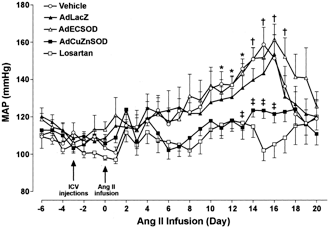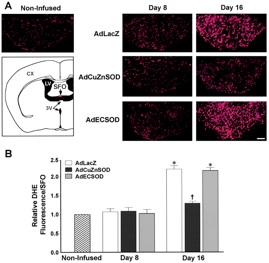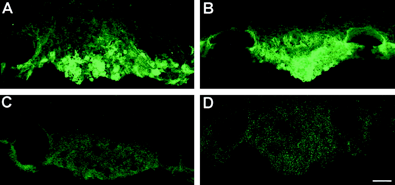Oxidant mechanisms in central neural control of blood pressure
- One of the most intriguing discoveries to emerge from our recent studies of neuro-cardiovascular regulation is that redox mechanisms are critically involved in central control of blood pressure, volume homeostasis and autonomic function.
- Furthermore, oxidative stress in the CNS plays a key role in the pathogenesis of neurogenic hypertension.
- We forged a new area of research as a result of our findings in 2002 that gene transfer of superoxide dismutase (SOD) selectively to the brain can abolish the cardiovascular and dipsogenic effects of centrally administered Ang-II.
- We have gone on to demonstrate that Ang-II-mediated oxidant stress in the CNS, particularly in cardiovascular nuclei that lie outside the blood-brain-barrier (the so-called circumventricular organs), is a key mechanism by which increased circulating Ang-II causes hypertension.
- Three different models used to study this include:
- "Slow-pressor" infusion model of Ang-II hypertension
- Goldblatt two-kidney, one-clip (2K1C) model of renovascular hypertension
- Double transgenic R+/A+ mice
- Furthermore, using viral-mediated delivery of dominant-negative inhibitors and other transgenes, we recently provided the first evidence that Nox2 and Nox4 NADPH oxidases are major source of Ang-II-induced superoxide production in neurons and play important and distinct roles in the central cardiovascular and dipsogenic effects of Ang-II.
- A primary focus now is on establishing the cellular and molecular mechanisms by which Ang-II-induced superoxide production leads to central neural activation and the subsequent physiological effects. A genomics-based research strategy continues to be a critical component of this work.

Increased scavenging of cytoplasmic O2 - in the brain prevents Ang-II-induced hypertension.

Ang-II infusion causes increased intracellular O2 - production in the SFO.

Adenoviral - mediated SOD expression is robust and localized to the SFO.


